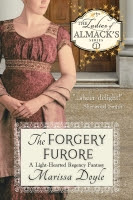What was up with fabrics in May 1809? Let’s have a look! As I did in the first post on Regency fabrics, I'll give you a close-up scan of each sample, the published description, and my own observations of the color, weight, condition, and similarity to present-day materials, to give you as close a picture as possible of what these fabrics are like. I hope this will prove of interest to Regency fiction writers and readers and all lovers of Regency costume.
May's fabric samples include four items, this month all for dress-making.
This pattern, No. 1, is the Adairian dot, a novel article, of an
uncommonly neat and elegant appearance, yard and a half wide, and
exquisitely adapted for ladies’ morning dresses. It is manufactured in
the north of England, and furnished us by Mrs. Thomas and Co. corner of
Chancery-lane.
My comments: This appears to be a lightly textured woven cotton, light in weight like a fine dress blouse material but I suspect would drape nicely. Note the fabric width--a yard and a half--which would have made this an economical fabric to use.
No. 2 is a white and lilac figured sarsnet, half yard wide, much in
fashion for pelisses. It is the manufacture of Harris, Moody, and Co.
Pall-Mall.
My comments: I am not precisely sure of the fiber here--silk, perhaps?--as it is fairly light in weight but has a lovely sheen, especially in the satin-like appearance of the flower petals. This fabric could almost have been used on either side, as the reverse is as finished as the front, but with the flowers in white. The color is more pink that what we would call lilac today, but I can't be sure that the dye hasn't faded or otherwise changed in the two-hundred odd years since this sample was made.
No. 3 is a Turkish figured gauze, half yard wide, for dresses, worn in a variety of colours, but principally in that of which we have given the pattern. It is furnished us by the manufacturers, Robarts, Plowman, and Snuggs, of Chandos-street, Covent-garden.
My comments: I would be tempted to call this a net more than a gauze today, as the weave is very open; it would certainly have to be worn with a slip or underdress! It is not at all stiff, though, and would drape nicely. But as someone who's done a fair bit of both fashion and home sewing, I can't imagine what it would be like to have to piece a dress pattern on 18" wide fabric...which maybe helps explain why the bodices on many Regency gowns were pieced as they were.
No. 4. is called printed India rib. It is a species of marcella, and is, at this moment, a very fashionable article for gentlemen’s waistcoats. It is furnished us by Messrs. Kesteven and Co., York-street, Covent-garden.
My comments: It's a little hard to say whether the original color here is the darker brown at upper and right of the sample, or the more beige hue at lower left. The fabric weight is fairly sturdy and stiff, almost like a light twill--the fabric body itself is ribbed, as you can just make out in the white spaces between the printed diamond pattern. "Marcella" is defined as "a cotton or linen fabric constructed in pique weave, used in the manufacture of vests, mats, etc.", though I wouldn't call this particular fabric a pique weave.
Subscribe to:
Post Comments (Atom)










5 comments:
Aha! So that's sarsnet! I know a few costumers who have been tearing their hair out trying to figure out what that material really looked like. Thank you for sharing, my dear!
Yup, that's sarsnet...or at least one. There are more coming up in future prints.
Where do you find this stuff? So cool! I recently just re-read one of Marion Chesney's series. She was my intro to Regency romance and I LOVE her books. They are my comfort, 'home' reads.
Glad you liked it, Leandra--it's pretty cool to see actual fabric--gives more life to the images we see in fashion prints.
Awesome! Thanks for sharing. The RI School of Design has a textile learning center where you can pull out drawers and look at old clothing. They had a few pieces from this period, but unfortunately they don't let you touch.
Post a Comment